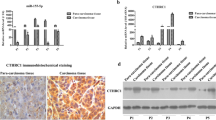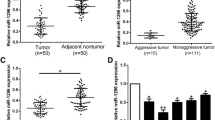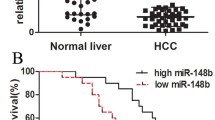Abstract
Sirtuin 1 (SIRT1) participates in the initiation and evolution of hepatocellular carcinoma (HCC). However, the specific mechanism of SIRT1 in HCC remains unclear. The mRNA expression of miR-29a in HCC were identified by qRT-PCR. miR-29a mimic and inhibitor were employed. The alteration of biological behavior was evaluated by Cell Counting Kit-8 (CCK8), clone formation, transwell and wound-healing assay. SIRT1 was verified to be a target gene which directly regulated by miR-29a. Luciferase reporter assay and co-IP were employed to evaluate the direct binding of miR-29a and SIRT1. Animal model was used to evaluate its function on tumor growth and metastasis in vivo. The relationship between miR-29a/SIRT1 and prognosis of HCC patients was analyzed. SIRT1 overexpression accompanied by low expression of miR-29a were detected in HCC which was negatively correlated, and associated with overall survival, vascular invasion and TNM stage. Up-regulation of miR-29a suppressed cell growth and motility. Deprivation of miR-29a expression led to opposite effect. The direct binding of miR-29a to SIRT1 was confirmed by luciferase reporter assay and co-IP. miR-29a repressed SIRT1, DKK2 and β-catenin, but their expression was obviously elevated by miR-29a inhibitor. Animal model suggested miR-29a could reduce the expression of SIRT1, thereby inhibiting HCC growth and metastasis by inactivating Wnt/β-catenin pathway. Low expression of miR-29a and high expression of SIRT1 predicted shorter survival time in HCC patients. miR-29a had the function of tumor suppressor which directly inhibited oncogenic SIRT1. The loss of miR-29a led to up-regulation of SIRT1, aggravate malignant transformation and poor prognosis of HCC.






Similar content being viewed by others
Data Availability
The datasets used and/or analyzed during the current study are available from the corresponding author on reasonable request.
Abbreviations
- SIRT1:
-
Sirtuin 1
- LC:
-
Liver cancer
- HCC:
-
Hepatocellular carcinoma
- miR-29:
-
MicroRNA-29
- UTR:
-
Untranslated region
- TACE:
-
Transcatheter arterial chemoembolization
- NC:
-
Negative control
- OE:
-
Overexpression
- qRT-PCR:
-
Quantitative reverse transcription-polymerase chain reaction
- CCK8:
-
Cell counting kit-8
- OD:
-
Optical density
- OS:
-
Overall survival
- PBS:
-
Phosphatebuffered saline
- IHC:
-
Immunohistochemistry
- DAB:
-
Diaminobenzidine
- HRP:
-
Horseradish peroxidase
- SDS-PAGE:
-
Sodium dodecyl sulphate/polyacrylamide gel electrophoresis
- SPF:
-
Specific pathogen-free
References
Bae HJ, Noh JH, Kim JK, Eun JW, Jung KH, Kim MG et al (2013) MicroRNA-29c functions as a tumor suppressor by direct targeting oncogenic SIRT1 in hepatocellular carcinoma. Oncogene 33:2557–2567
Chen J, Zhang B, Wong N, Lo AW, To KF, Chan AW et al (2011) Sirtuin 1 is upregulated in a subset of hepatocellular carcinomas where it is essential for telomere maintenance and tumor cell growth. Cancer Res 71:4138–4149
Chen J, Jiang Q, Jiang XQ, Li DQ, Jiang XC, Wu XB et al (2020) miR-146a promoted breast cancer proliferation and invasion by regulating NM23-H1. J Biochem 167:41–48
Edatt L, Poyyakkara A, Raji GR, Ramachandran V, Shankar SS, Kumar VBS (2020) Role of sirtuins in tumor angiogenesis. Front Oncol 9:1516
Faramin Lashkarian M, Hashemipour N, Niaraki N, Soghala S, Moradi A, Sarhangi S et al (2023) MicroRNA-122 in human cancers: from mechanistic to clinical perspectives. Cancer Cell Int 23:29
Fattahi M, Shahrabi S, Saadatpour F, Rezaee D, Beyglu Z, Delavari S et al (2023) microRNA-382 as a tumor suppressor? Roles in tumorigenesis and clinical significance. Int J Biol Macromol 250:125863
Gu Y, Wang Y, He L, Zhang J, Zhu X, Liu N et al (2021) Circular RNA circIPO11 drives self-renewal of liver cancer initiating cells via hedgehog signaling. Mol Cancer 20:132
Hanahan D, Weinberg RA (2011) Hallmarks of cancer: the next generation. Cell 144:646–674
He S, Tang S (2020) WNT/beta-catenin signaling in the development of liver cancers. Biomed Pharmacother 132:110851
Herranz D, Muñoz-Martin M, Cañamero M, Mulero F, Martinez-Pastor B, Fernandez-Capetillo O et al (2010) Sirt1 improves healthy ageing and protects from metabolic syndrome-associated cancer. Nat Commun 1:3
Holloway KR, Calhoun TN, Saxena M, Metoyer CF, Kandler EF, Rivera CA et al (2010) SIRT1 regulates Dishevelled proteins and promotes transient and constitutive Wnt signaling. Proc Natl Acad Sci USA 107:9216–9221
Jang KY, Noh SJ, Lehwald N, Tao GZ, Bellovin DI, Park HS et al (2012) SIRT1 and c-Myc promote liver tumor cell survival and predict poor survival of human hepatocellular carcinomas. PLoS ONE 7:e45119
Kulik L, El-Serag HB (2019) Epidemiology and management of hepatocellular carcinoma. Gastroenterology 156:477-491.e1
Laemmle A, Lechleiter A, Roh V, Schwarz C, Portmann S, Furer C et al (2012) Inhibition of SIRT1 impairs the accumulation and transcriptional activity of HIF-1α protein under hypoxic conditions. PLoS ONE 7:e33433
Liang G, Meng W, Huang X, Zhu W, Yin C, Wang C et al (2020) miR-196b-5p-mediated downregulation of TSPAN12 and GATA6 promotes tumor progression in non-small cell lung cancer. Proc Natl Acad Sci USA 117:4347–4357
Lim CS (2006) SIRT1: tumor promoter or tumor suppressor? Med Hypotheses 67:341–344
Liu G, Bi Y, Shen B, Yang H, Zhang Y, Wang X et al (2014) SIRT1 limits the function and fate of myeloid-derived suppressor cells in tumors by orchestrating HIF-1α-dependent glycolysis. Cancer Res 74:727–737
Liu L, Liu C, Zhang Q, Shen J, Zhang H, Shan J et al (2016) SIRT1-mediated transcriptional regulation of SOX2 is important for self-renewal of liver cancer stem cells. Hepatology 64:814–827
Meng F, Henson R, Wehbe-Janek H, Ghoshal K, Jacob ST, Patel T (2007) MicroRNA-21 regulates expression of the PTEN tumor suppressor gene in human hepatocellular cancer. Gastroenterology 133:647–658
Ming M, Soltani K, Shea CR, Li X, He YY (2015) Dual role of SIRT1 in UVB-induced skin tumorigenesis. Oncogene 34:357–363
Prola A, Pires Da Silva J, Guilbert A, Lecru L, Piquereau J, Ribeiro M et al (2017) SIRT1 protects the heart from ER stress-induced cell death through eIF2α deacetylation. Cell Death Differ 24:343–356
Qian L, Su H, Wang G, Li B, Shen G, Gao Q (2020) Anti-tumor activity of bufalin by inhibiting MET mediated MEK/ERK and PI3K/AKT signaling pathways in gallbladder cancer. J Cancer 11:3114–3123
Shah C, Mramba LK, Bishnoi R, Bejjanki H, Chhatrala HS, Chandana SR (2017) Survival differences among patients with hepatocellular carcinoma based on the stage of disease and therapy received: pre and post sorafenib era. J Gastrointest Oncol 8:789–798
Shirvani H, Ghanavi J, Aliabadi A, Mousavinasab F, Talebi M, Majidpoor J et al (2023) MiR-211 plays a dual role in cancer development: From tumor suppressor to tumor enhancer. Cell Signal 101:110504
Sung H, Ferlay J, Siegel RL, Laversanne M, Soerjomataram I, Jemal A et al (2021) Global Cancer Statistics 2020: GLOBOCAN estimates of incidence and mortality worldwide for 36 cancers in 185 countries. CA Cancer J Clin 71:209–249
Visvader JE (2011) Cells of origin in cancer. Nature 469:314–322
Wang RH, Sengupta K, Li C, Kim HS, Cao L, Xiao C et al (2008) Impaired DNA damage response, genome instability, and tumorigenesis in SIRT1 mutant mice. Cancer Cell 14:312–323
Wang MJ, Chen JJ, Song SH, Su J, Zhao LH, Liu QG et al (2021) Inhibition of SIRT1 limits self-renewal and oncogenesis by inducing senescence of liver cancer stem cells. J Hepatocell Carcinoma 8:685–699
World Health Organization. Mortality Database. Health Statistics and Information Systems. Geneva, Switzerland: WHO. Accessed 31 Jan 2020
Wörns MA, Galle PR (2014) HCC therapies-lessons learned. Nat Rev Gastroenterol Hepatol 11:447–452
Xie Y, Liu J, Jiang H, Wang J, Li X, Wang J et al (2020) Proteasome inhibitor induced SIRT1 deacetylates GLI2 to enhance hedgehog signaling activity and drug resistance in multiple myeloma. Oncogene 39:922–934
Xiong Y, Fang JH, Yun JP, Yang J, Zhang Y, Jia WH et al (2010) Effects of microRNA-29 on apoptosis, tumorigenicity, and prognosis of hepatocellular carcinoma. Hepatology 51:836–845
Yu L, Dong L, Li H, Liu Z, Luo Z, Duan G et al (2020) Ubiquitination-mediated degradation of SIRT1 by SMURF2 suppresses CRC cell proliferation and tumorigenesis. Oncogene 39:4450–4464
Zhang S, Yang Y, Huang S, Deng C, Zhou S, Yang J et al (2019) SIRT1 inhibits gastric cancer proliferation and metastasis via STAT3/MMP-13 signaling. J Cell Physiol 234:15395–15406
Zhao B, Li X, Zhou L, Wang Y, Shang P (2019) SIRT1: a potential tumour biomarker and therapeutic target. J Drug Target 27:1046–1052
Funding
Not applicable.
Author information
Authors and Affiliations
Contributions
LQQ designed and analyzed the research study and wrote the manuscript; YJZ, GW, BL, HMZ and JQ collected and analyzed the data; LQ supervised the study, provided suggestive advice for the experiments, reviewed and edited manuscript.
Corresponding author
Ethics declarations
Competing interests
The authors declare that they have no competing interests.
Consent for Publication
Not applicable.
Ethical Approval and Consent to Participate
The collection and use of clinical resources which performed in accordance with guidelines was complied with the permission of Biomedical Ethics Committee of Suzhou Ninth People’s Hospital (Approval number: KY2022-088-01, Suzhou, China). The written consent from each patient has been provided, which was conducted in accordance with the declaration of Helsinki. The procedures for animal models were approved by the Ethics Committee of Suzhou Ninth People’s Hospital (Approval number: KY2022-088-01, Suzhou, China), which was conducted in accordance with the declaration of Helsinki.
Additional information
Publisher's Note
Springer Nature remains neutral with regard to jurisdictional claims in published maps and institutional affiliations.
Rights and permissions
Springer Nature or its licensor (e.g. a society or other partner) holds exclusive rights to this article under a publishing agreement with the author(s) or other rightsholder(s); author self-archiving of the accepted manuscript version of this article is solely governed by the terms of such publishing agreement and applicable law.
About this article
Cite this article
Qian, L., Zhang, Y., Wang, G. et al. miR-29a-SIRT1-Wnt/β-Catenin Axis Regulates Tumor Progression and Survival in Hepatocellular Carcinoma. Biochem Genet (2023). https://doi.org/10.1007/s10528-023-10521-7
Received:
Accepted:
Published:
DOI: https://doi.org/10.1007/s10528-023-10521-7




